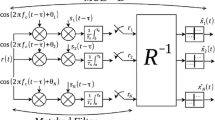Abstract
An adaptive bit allocation algorithm is proposed for multiuser transmission in OFDM/CDMA systems. The proposed scheme takes advantage of frequency diversity to dynamically allocate a suitable number of bits/per symbol on subcarriers of each user based on the transmitting objectives such as the required transmission rate and BER. A suboptimal solution to the problem of the bit allocation on subcarriers for each user is derived by minimizing the interference power from each user. Then an algorithm for adjusting the number of allocated bits is used to further reduce the interference without changing the total transmitted data rate. The performance obtained by minimizing the interference resulting from each user is studied in terms of BER, transmission data rate and the system capacity supporting multiple users. The theoretical analysis and simulation results show that the proposed algorithm substantially outperforms those reported previously.
Similar content being viewed by others
References
Cimini, L. J., & Sollenberger, N. R. (1997). OFDM with diversity and coding for high-bit-rate mobile data applications. Mobile Multimedia Communications, 1, 247–254.
Hanzo, L., Münster, M., Choi, B. J., & Keller, T. (2003). OFDM and MC-CDMA for Broadband Multi-user Communications, WLANs and Broadcasting. New York: Wiley.
Engels, M. (2002). Wireless OFDM Systems: How to make them work? Kluwer Academic Publishers.
Hanzo, L., Webb, W., & Keller, T. (2000). Single- and multi-carrier quadrature amplitude modulation: Principles and applicartions for personal communications, WLANs and Broadcasting. John Wiley & Sons.
Hara, S., & Prasad, R. (1997). Overview of multicarrier cdma. IEEE Communications Magazine, 35, 126–133.
Sourour, E. A., & Nakagawa, M. (1996). Performance of orthogonal multicarrier CDMA in a multipath fading channel. IEEE Journal on Selected Areas in Communications, 44, 356–367.
Qiu, X., & Chawla, K. (1999). On the performance of adaptive modulation in cellular systems. IEEE Transactions on Communications, 47, 884–895.
Choi, B.-J., & Hanzo, L. (2001). Optimum mode-switching assisted adaptive modulation. Proceedings of Globecom’01, 6, 25–29.
Jang, J., & Bok Lee K. (2003). Transmit power adaptation for multiuser OFDM systems. IEEE Journal on Selected Areas in Communications, 21(2), 171–178.
Zhang, Y., & Letaief, K. B. (2002). Multiuser subcarrier and bit allocation along with adaptive cell selection for OFDM transmission. Proceedings of ICC’02, 2, 861–865.
Canpolat, B., & Tanik, Y. (2004). Performance analysis of adaptive loading OFDM under rayleigh fading. IEEE Transactions on Vehicle Technology, 53, 1105–1115.
Goldsmith, A. J., & Chua, S.-G. (1997). Variable-rate variable-power MQAM for fading channel. IEEE Transactions on Communications, 45, 1218–1230.
Song, G., & Li, Y. (2003). Adaptive subcarrier and power allocation in OFDM based on maximizing utility. Proceedings of VTC’03, 2, 905–909.
Wong, C. Y., Cheng, R. S., Letaief, K. B., & Murch, R. D. (1999). Multiuser OFDM with adaptive subcarrier, bit, and power allocation. IEEE Journal on Selected Areas in Communications, 17, 1747–1757.
Canpolat, B., & Tanik, Y. (2001). Performance of adaptively loaded OFDM under Rayleigh fading with diversity combining. Proceedings of IEEE VTC’2001, 2, 957–961.
Blogh, J. S., Cherriman, P. J., & Hanzo, L. (2001). Dynamic channel allocation techniques using adaptive modulation and adaptive antennas. IEEE Journal on Selected Areas in Communications, 18, 12–21.
Kivanc, D., & Liu, H. (2000). Subcarrier allocation and power control for OFDMA. Proceedings of Conference Record of the Thirty-Fourth Asilomar Conference on Signals Systems and Computers, 1, 147–151.
Keller, T., & Hanzo, L. (2000). Adaptive modulation techniques for duplex OFDM transmission. IEEE Transactions on Vehicle Technology, 49, 1893–1906.
Gerakoulis, D., & Geraniotis, E. (2001). CDMA: access and switching. New York: Wiley.
Zhou, X., & Wang, X. (2003). Channel Estimation for OFDM Systems Using Adaptive Radial Basis Function Networks. IEEE Transactions on Vehicle Technology, 1, 48–59.
Cavers, J. K. (2003). An analysis of pilot symbol assisted modulation for Rayleigh fading channels. IEEE Transactions on Vehicle Technology, 40, 686–693.
Proakis, J. G. (1995). Digital communications (3rd ed.). New York: McGrawHill.
Luenberger, D. G. (1969). Optimization by vector space methods. New York: Wiley.
Lee, J. S., & Miller, L. E. (1998). CDMA system engineering handbook. Boston, London: Artech House.
Bader, F., Zazo, S., & Paez Borrallo, J. M. (2000). Uplink acquisition of synchronization parameters in MC-CDMA systems. Proceedings of VTC’2000, 5, 2140–2145.
Hyo Kim, S., Ha, K., & Woong Lee, C. (1999). A frame synchronization scheme for uplink MC-CDMA. Proceedings of VTC’1999, 4, 2188–2192.
Agee, B. G., Kleinman, R. J., & Reed, J. H. (1996). Soft synchronization of direct sequence spread-spectrum signals. IEEE Transactions on Communications, 44, 1527–1536.
Proakis, J. G. (1989). Digital communications (2nd ed.). New York: McGrawHill.
Korn, I. (1985). Digital communications. New York: Van Nostrand.
Simon, M. K., Hinedi, S. M., & Lindsey, W. C. (1995). Digital communications techniques-signal design and detection. Englewood Cliffs, NJ: Prentice Hall.
Papoulis, A. (1991). Probability, random variables and stochastic processes. New York: McGrawHill.
Author information
Authors and Affiliations
Corresponding author
Rights and permissions
About this article
Cite this article
Zhang, H., Bi, G. & Zhang, L. New adaptive bit allocation algorithms for multiuser OFDM/CDMA systems. Wireless Netw 15, 341–351 (2009). https://doi.org/10.1007/s11276-007-0053-6
Published:
Issue Date:
DOI: https://doi.org/10.1007/s11276-007-0053-6




